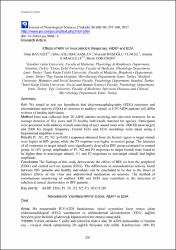Effects of HIV on neuroelectric responses: AERP and EDA
Künye
Bayazıt, O., Atlı Kocaaslan, S., Başoğlu Tuncel, M., Karagülle, A. ve Gökengin, D. (2017). Effects of HIV on neuroelectric responses: AERP and EDA. Journal of Neurological Sciences-Turkish, 34(4), 291-300. https://dx.doi.org/10.24165/jns.9860.16Özet
Aim We aimed to test our hypothesis that electroencephalography (EEG) responses and electrodermal activity (EDA) in response to auditory stimuli in HIV/AIDS patients will differ to those of healthy individuals. Method Data was collected from 20 AIDS patients receiving anti retroviral treatment for an average duration of five years and 20 healthy individuals matched for age/sex. Participants were presented with auditory stimuli consisting of pure sound tones with 1000 Hz (non-target) and 2000 Hz (target) frequency. Frontal EEG and EDA recordings were taken using a biopotential amplifier system. Results P1, N1, P2, N2 (p<0.001) responses obtained from the frontal region to target stimuli were higher in HIV group; while the P3 response was higher in control group. The latencies of all responses to target stimuli were significantly delayed in HIV group compared to control group. In HIV group, amplitudes of P1, N2 and P3 responses to target stimuli were found to be higher than to non-target stimuli; N1 and P2 responses to non-target stimuli had higher amplitude. Conclusion The findings of this study demonstrate the effects of HIV on both the peripheral (EDA) and central nervous system (EEG). The differences in neuroelectrical activity found between HIV patients and healthy individuals can be concluded to be due to the direct or indirect effects of the virus and antiretroviral medication on neurons. The method of simultaneous monitoring of auditory ERP and EDA may contribute to the detection of subclinical neural deterioration in HIV patients. Amaç Bu araştırmada HIV/AIDS hastalarının, işitsel uyaranlara karşı ortaya çıkan elektroensefalografi (EEG) yanıtlarının ve elektrodermal aktivitelerinin (EDA) sağlıklı bireylere göre farklılık göstereceği hipotezimizi test etmeyi amaçladık. Yöntem Veriler ortalama 5 yıldır anti retroviral tedavi alan 20 AIDS hastasından ve bunlara yaş - cinsiyet olarak eşleştirilmiş 20 sağlıklı bireyden elde edildi. Katılımcılara 1000 Hz (hedef olmayan) ile 2000 Hz (hedef) frekansına sahip saf ses tonundan oluşan işitsel uyaranlar dinletildi. Taşınabilir biyopotansiyel anfi sistemi ile frontal EEG ve EDA kayıtlaması yapıldı. Bulgular Frontal bölgede, hedef uyaranlara karşı alınan P1, N1, P2, N2 (p<0.001) yanıtlarında HIV grubu daha yüksek iken; P3 yanıtı kontrol grubunda daha yüksekti. Hedef uyaranlara karşı alınan tüm yanıtların latansları HIV grubunda kontrol grubuna göre istatistiksel olarak anlamlı derecede gecikmişti. HIV grubunda hedef uyaranlara karşı elde edilen P1, N2 ve P3 yanıtlarının genlikleri, hedef olmayan uyaranlara göre daha yüksek bulundu. N1 ve P2 yanıtları hedef olmayan uyaran için daha yüksek genlikliydi. Kontrol grubunda hedef uyaranlara karşı elde edilen P1, P2 ve P3 yanıtlarının genlikleri, hedef olmayan uyaranlara göre daha yüksekti. Kontrol grubunda N1 ve N2 yanıtları hedef olmayan uyaran için daha yüksek bulundu. Sonuç Bu çalışmanın bulguları HIV"in hem periferal hem de merkezi sinir sistemi üzerindeki etkilerini EEG ve EDA verileriyle göstermektedir. HIV ile enfekte hastalar ve kontrol grubu arasında bulunan nöroelektrik aktivite farklılıklarının altında virüsün ve antiretroviral ilaçların nöronlar üzerindeki direk veya dolaylı etkilerinden kaynaklandığı söylenebilir. İşitsel ERP ve eş zamanlı alınan EDA izlenmesi metodunun HIV hastalarında subklinik nöral bozulmaların belirlenmesine katkısı olabilir.


















